In the same way that a well-manicured lawn requires a good lawn mower, you need a good hedge trimmer to keep your hedges nice and neat. The best hedge trimmer for you depends on your needs and priorities. We’re exploring the different types of hedge trimmers and how to get the most out of each one.
Hedge Trimmers – What are they?
In short, hedge trimmers are gardening tools that are meant primarily for cutting and shaping hedges. They have a long cutting bar that moves back and forth quickly along the toothed blade, evenly cutting small branches from shrubs. You can find them in gas-powered, electric (corded), and battery-powered varieties.
While most people acquire a hedge trimmer for the purpose of trimming hedges, they can also be used for other jobs as well. You can cut brush, knock back overgrown weeds, and clear bushy areas of your yard, too.
But before you choose a hedge trimmer, there’s a lot to consider. In this guide, we’ll go over everything you need to know to make an informed purchase.
Types of Hedge Trimmers
So, how do you determine what kind of hedge trimmer is best for your yard? Let’s go over the three basic types of hedge trimmers to find out how they’re used, and the pros/cons of each type.
Electric Hedge Trimmers
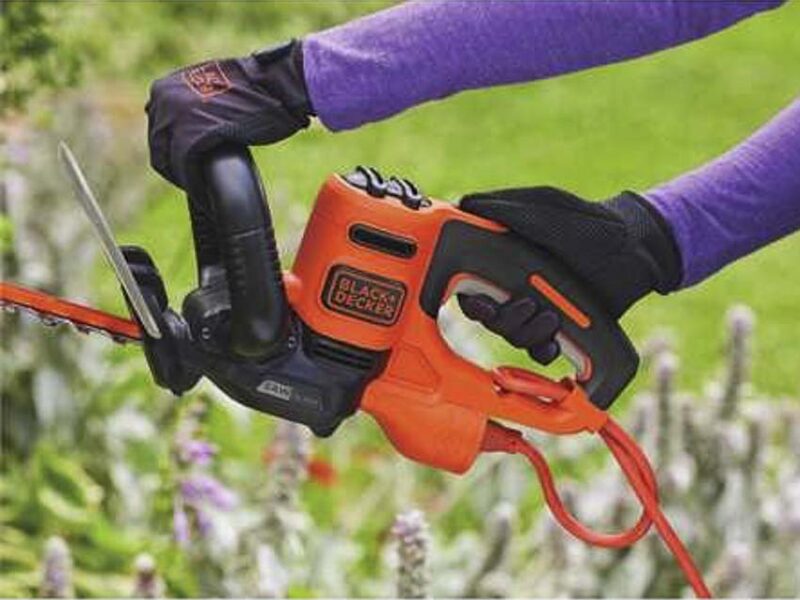
Electric hedge trimmers are those that are powered by an extension cord connected to an outlet. Of the three main types of hedge trimmers, electric models tend to be the least expensive option. They also let you avoid messy refueling or running out of gas.
Corded-electric hedge trimmers are much quieter than gas-powered models. However, on the downside, they can’t really compete with gas models when it comes to power and performance.
Another advantage of electric hedge trimmers is their weight. Compared to gas and even battery-powered models, an electric hedge trimmer’s lightweight blueprint really comes in handy, especially since you usually have to hold them at off angles for long periods of time.
The average cost of an electric hedge trimmer ranges from around $60 to $150, making them very affordable. However, if you don’t already own an extension cord that’s compatible with this product, make sure to factor that into your overall budget.
Finally, as with all corded power tools, it’s important to consider the fact that your cord length will limit you. If your hedges are far away from an outlet, you’ll need a 16-gauge extension cord that’s at least 100 feet long.
Cordless (Battery-Powered) Hedge Trimmers
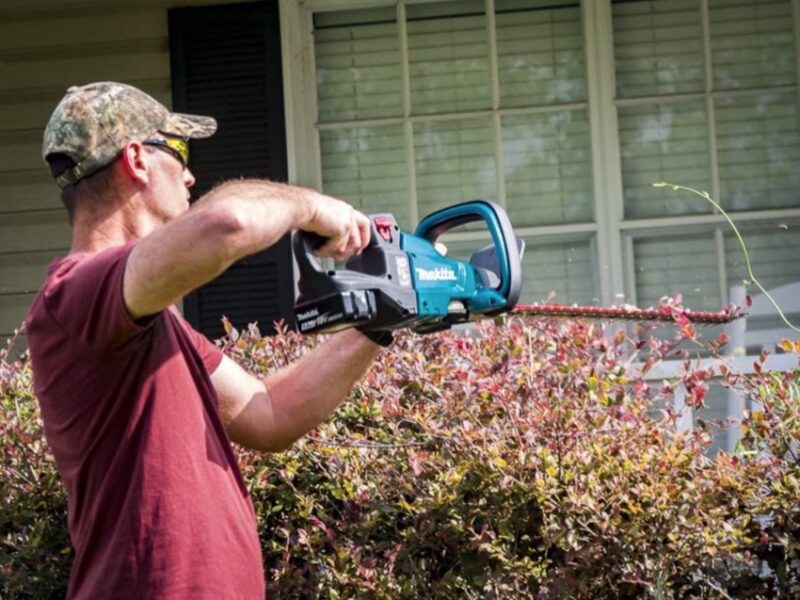
Alternately, battery-powered hedge trimmers don’t require a cord, and they also let you avoid the hassles of gas.
Over the last decade, battery-powered tools have made significant advancements. Nowadays, most cordless models can compete with their gas counterparts. Battery-powered hedge trimmers can last around 2 hours on a single charge, which is more than enough for the average homeowner.
Another bonus to cordless hedge trimmers is their lack of emissions, making them more environmentally friendly. However, they require more power for difficult tasks like cutting thick branches, which can drain your battery more quickly.
Depending on the brand, a battery-powered hedge trimmer can cost around $60 to $200, making it affordable for the average homeowner. However, they also require batteries and chargers, so if you don’t have those you’ll need to factor them into your budget. If you’re already part of a cordless tool platform, consider a hedge trimmer that uses the same battery to save money.
Gas-Powered Hedge Trimmers
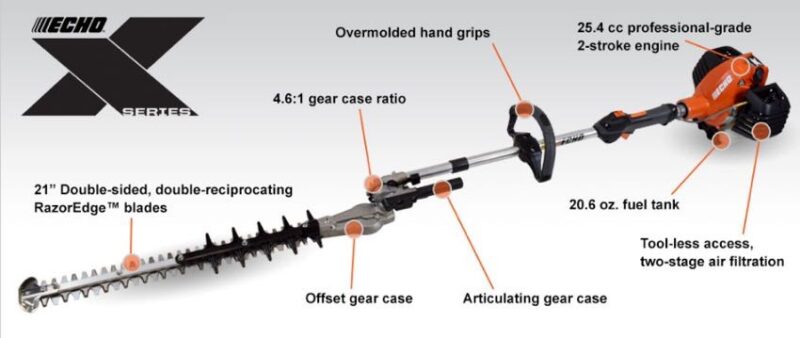
Gas-powered hedge trimmers are the best types if your priorities are high power and long runtimes. They’re popular with commercial landscapers and people with large properties with several hedges to maintain. Gas-powered models are ideal for tough tasks, like clearing heavy brush and cutting branches around 1 inch thick.
One disadvantage of gas-powered hedge trimmers is that they require more maintenance than their corded and battery counterparts. Before putting them away at the end of the year, they require winterization, and they also need to be tuned up regularly to stay running properly.
Hedge Trimmer Features
Hedge trimmers come in a variety of styles and with many different features. Consider the features you’re looking for when shopping for the best hedge trimmer for your yard.
Blade Type
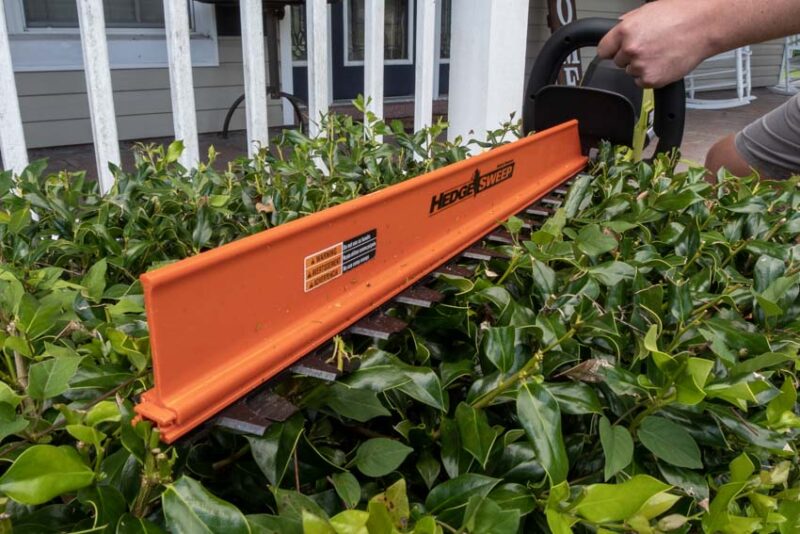
After the power source, blade type is the next most important feature to look for on a hedge trimmer. There are two main options— single-action and double-action.
Single-action hedge trimmers have one stationary blade and one that moves. Double-action models have blades that move against each other.
The advantage of single-action hedge trimmers is that the blades can be longer, which is better for wide hedges. They’re also less expensive and don’t require as much maintenance.
Double-action hedge trimmers are better at cutting and they provide reduced vibration levels. Since they offer better performance, they’re often more expensive than their single-action counterparts. Another benefit is that they are easier for left-handed people to operate.
Blade Length
Most standard hedge trimmers have blades that are anywhere from 13 to 40 inches long. Some of the smallest models that are made for detailing can have blades as short as 5 inches. Contrarily, some of the largest hedge trimmers can have blades up to 48 inches in length.
Here are some common blade lengths and applications:
| Hedge trimmer blade length | Best for |
| 16 inches or less | Small- to medium-sized hedges |
| 18 inches | Average-sized hedges |
| 20 inches and up | Large hedges with thick branches |
Blade Teeth Spacing
Hedge trimmer teeth spacing determines the thickness of the material that the trimmer can cut through. Blade teeth spacing gaps usually range from 0.5 inches to 1.5 inches.
Weight
The most lightweight hedge trimmers are corded electric models. Some of these models can weigh less than four pounds, which is light enough for anyone to use easily.
The heaviest hedge trimmers are gas-powered models, which can weigh around 10 to 12 pounds. Since they have more power, they usually have longer blades. The fuel tank and added fuel also contribute to the overall weight.
Safety Features
Other than size and weight, there are several other built-in safety features to look for on hedge trimmers:
- Tooth extensions that prevent contact and minimize the chances of getting cut.
- Dual switches for safer two-handed operation.
- Trigger switches that cut power to the blades as soon as the trigger is released.
- Lock buttons that protect small children by preventing accidental activation.
- Front handle shields and blade guards to prevent accidents.
Exploring the Benefits of Hedge Trimmers

Hedge trimmers are essential tools for tidy landscaping, especially for homes with a formal garden. If you’re on the fence about getting a hedge trimmer, we’ll go over some common benefits to help you decide if it’s a tool you need for your yard.
Neat and Tidy Landscaping
While a sprawling, wild garden is preferable to some, others prefer a neat and tidy landscape with well-manicured hedges and shrubs. A hedge trimmer can help you shape your shrubs into different designs to add visual interest to your property.
Efficient and Time-Saving
With the alternative being manual pruners or shears, a hedge trimmer can save you tons of time when trimming shrubs around your home. They make it easy to maintain hedges of any size, and they also work great for shrubs that are growing wild and unchecked.
You can also use a hedge trimmer to clear undergrowth at your property’s edge, which helps discourage fleas, ticks, and other pests from hanging around your yard.
Health of Plants
Shrubs require regular pruning to eliminate dead or overgrown branches. When done properly, pruning can stimulate new growth, which results in a healthier hedge or shrub.
However, it is possible to over-prune your hedges. To avoid this, keep your pruning schedule down to once or twice a year, and avoid cutting back more than one-third of a shrub or tree.
How to Use Hedge Trimmers Effectively

What’s the best way to use a hedge trimmer? Follow these tips and safety precautions to get the most out of your hedge trimmer.
Safety Precautions
If not used properly, hedge trimmers can be dangerous. While many of these tools have built-in safety features to ensure your protection, you should still take the following precautions to ensure your safety:
- Always read the owner’s manual and follow the manufacturer’s instructions.
- Use extra caution when working in hard-to-reach areas.
- Keep two hands on the trimmer when it’s running.
- Keep at least 10 feet between you and other people or pets.
- Wear proper footwear, long pants, and long-sleeved shirts.
- Wear leather gloves to protect your fingers.
- Use eye and ear protection.
- Keep long hair in a ponytail, and don’t operate while wearing loose jewelry.
- Pay close attention to the cord when using electric hedge trimmers.
Shaping and Pruning
Shaping a bush into a ball requires more detail and finesse than an aggressive trim. The most effective technique is to use natural gentle pruning or light trims with soft cuts, but a hedge trimmer can also be used to make aggressive cuts and shape your bushes effectively.
Visualize the shape you want, make a couple of cuts, and step back to assess your shrub’s appearance. Continue this process until your shrub is shaped to your desire.
Maintenance and Cleaning
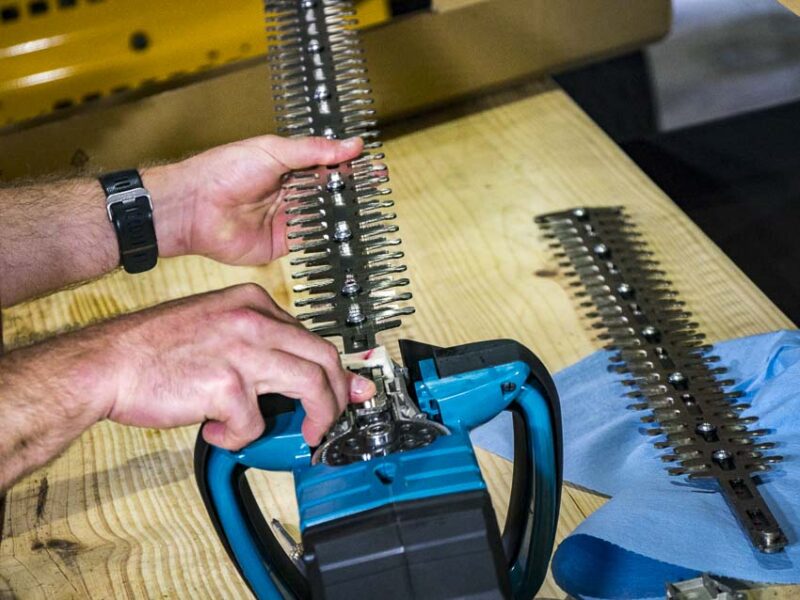
With proper care, your hedge trimmer will last years. There are several steps to taking care of your hedge trimmer, and like any power tool, the more use it gets, the more maintenance it will require.
After using your hedge trimmer, shut the power off, remove the battery, or unplug the cord. Clean the blades with a soapy rag, wipe dry with a clean cloth, and apply blade lubricant.
Remove the air filter and tap it to clean off any dust or debris. You may need to replace it, but don’t wash it unless the owner’s manual states that you can.
Finally, you should occasionally sharpen your hedge trimmer blades. The easiest way to sharpen them is by using a cone-shaped bit on a drill, but you can also use a normal flat file.
FAQ: Common Questions About Hedge Trimmers
1. Can I use hedge trimmers for other types of plants?
While hedge trimmers are designed to trim and shape hedges, they can also be used on other plants. They may not be the best tool for the job, but you can cut small tree branches, knock down large weeds, and even cut overgrown grass with relative ease using a hedge trimmer.
2. How often should I trim my hedges?
Not all hedges grow at the same rate, but most shrubs can get by with one to two cuts per year. One cut is enough for informal hedges, but many formal hedges should be trimmed two times per season. However, there are some quick-growing conifers that may be need to be trimmed more frequently.
3. Are cordless hedge trimmers as powerful as gas-powered ones?
While the majority of battery-powered tools (including hedge trimmers) aren’t quite as powerful as gas-powered ones, there are several pros and cons to going cordless. Battery-powered hedge trimmers are easier to maintain, and you don’t have to deal with the annoyances of using gas as a power source. However, the trade-off is that they’re less powerful and usually only operate for an hour or two per charge.
4. Can I trim hedges in any season?
The best time to prune hedges is during dormancy periods. Hedges go dormant in the fall and come out of dormancy during the spring growing season. Avoid pruning during the hottest part of the summer.
5. Is it possible to over-trim hedges?
It is possible to over-trim hedges and shrubs. Most shrubs should never be pruned back more than one-third of a shrub’s growth. Also, stick to a schedule of trimming only once or twice per year.
Related Content
How Much Should You Spend on Lawn Care?
Mulching vs Bagging Grass: Which is Better for Your Lawn
Choosing the Best Type of Lawn Mower for You



